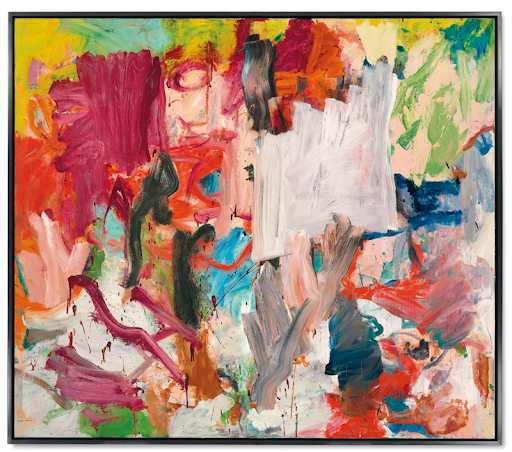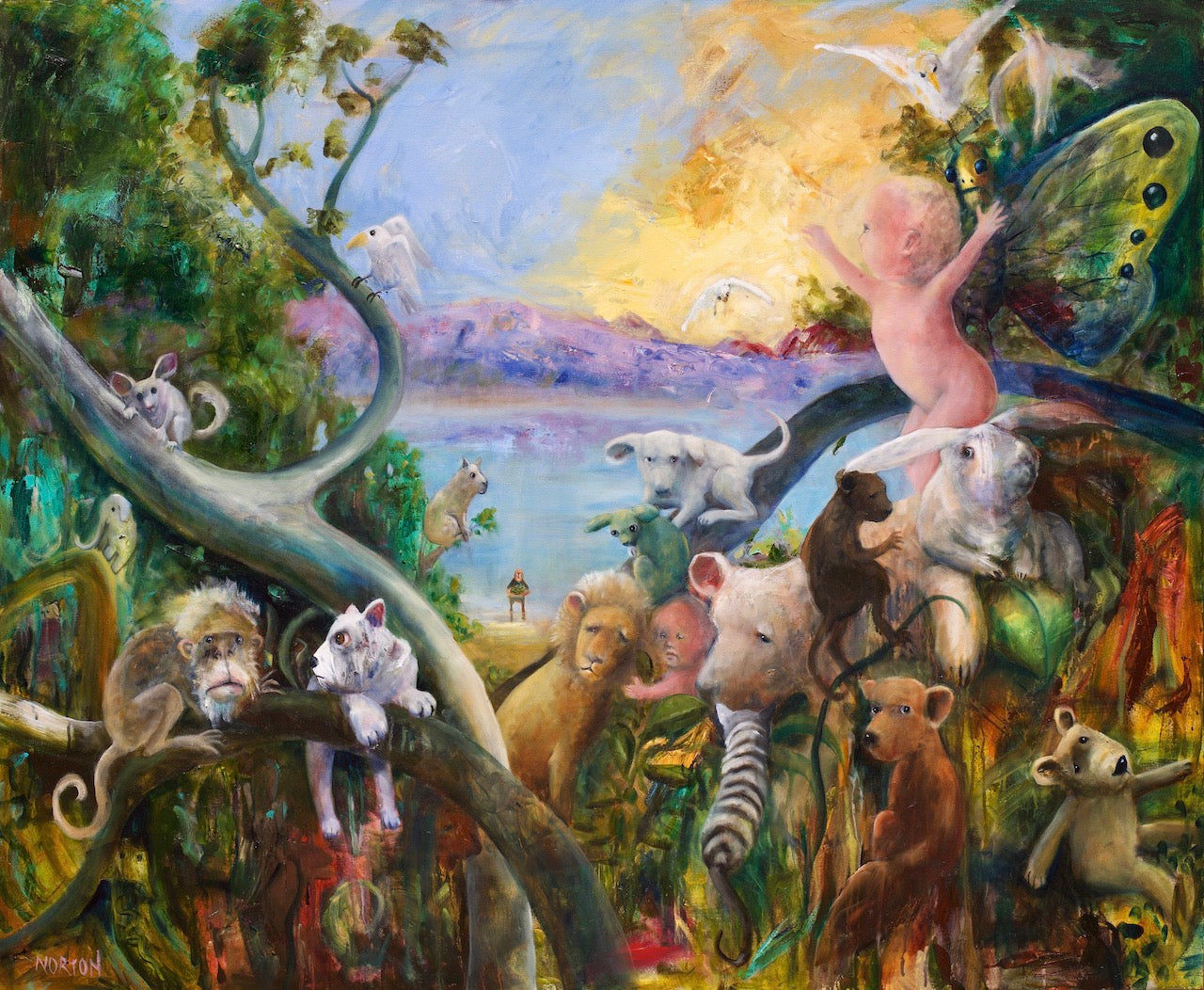Another common problem starting-out artists have is the problem of 'how will I know when it's finished?' Well, that question belongs to the same club. They cause each other and are slyly interlinked
WHY AND HOW TO LOOSEN UP YOUR PAINTING

LOOSENING UP
HOW TO STOP YOURSELF FROM TIGHTENING UP WHEN PAINTING

Willem de Kooning, Untitled XXV, 1977 Sold for $63 million in Christies action in 2016
The Problem
One of the greatest banes of visual artists lives is the problem of getting lost in the minutia of a painting. We always start well, with big, bold flourishing strokes of gesture. We love the underpainting because we know it's an underpainting, and we can do what we like - we just don't care, and so we are like children again, full of expression and energy. We forget about perfection. There's a clue there! Take note for later. I have never started a painting that I didn't want to stop at after the first fifteen minutes of this mad orgy of exciting activity. We all ask this - If only I dared to preserve this raw energy, this energetic, honest form. The truth of it is these first moves.
Image Below - “Out of Order” Helen Norton 1996

The main question I hear in my live workshops is, how do I stop getting so tight with my work? Firstly, I want to assure you that this is not a rookies issue. From my decades of being an artist, I happen to know that not only do I encounter this, but this is also a constant struggle for most professional artists with decades of experience and success.
Every artist no matter the level gets into this place, this horrible, frustrating, repetitive nightmare. The rabbit hole where nothing good happens, but we can't seem to stop going there from time to time. The more we do, the more we have to do, until hours upon hours, or weeks, we throw the brush across the room, launch out of our hunched over crippling focus and run out of the room screaming, longing for something, anything else.
Usually, the urge is to find some task that we can just do and complete. We do the dishes; we mop the floor, we make the bed, because it's clear, it's done when it's done. There is no grey area. It's black and white! The sink is clean, or it's not. The bed is made, or it's not and so on. Then we start saying things like I HATE ART, I want a regular job, art drives me crazy because I can't loosen up and it becomes a choir, and that's not art, I have failed, I am a failure, bla bla bla!
Well, - guess what? Even though choirs are clear enough, in their measure of completion - so can painting loose! It's all about trust and the courage to believe it to be true. Yeh, I know, it's a head thing, like everything. So let's dig in a little bit. Remember this is not the essential guide, or the comprehensive guide, just a few tips today for moving forward on the problem.
Mr Minutia and Mrs Never-Finished
Another common problem starting-out artists have is the problem of 'how will I know when it's finished?' Well, that question belongs to the same club. They cause each other and are slyly interlinked. Keep an eye out. Create two categories in your mind in case you see them rocking up. Draw them as ugly faces and pin them to the studio wall. Mr Minutia and Mrs Never Finished. Give them a character. It helps to remember. They are the enemy of productivity and creative flow. They are married.
Method
I was motivated to put these jottings into a little blog to help my students currently taking my Online Acrylic Workshop. This workshop is explicitly targeting this problem with a method.
The method is that I deliberately flip around between three paintings, and I do the entire bundle in about one hour. Of course, that's not what I expect you to do, but hey, try not to take too much longer than two! These works are just play-things. Imagine you are working with melting butter or better still - ice. We must not care about these works, because guess what ... you can do so many more painting and very quickly if you get the method - if you get the way of working fast! The technique, which I encourage you to follow along with as closely as you can (meaning use strokes and actions in the same way relatively speaking).
A great way to explain this is what happened when I tried going to the gym to do a step class. I was utterly hopeless. No coordination at all! All left feet for two weeks. I stumbled and bumbled my way through, and fell behind and wanted just to walk out because the instructor was a loudmouth who made fun of stumblers to try to encourage them? Well up hers! Eventually, I got there and could keep up. I nailed it. I changed my attitude to getting fit. I wanted to get fit, but because I was free from the trials of 'following to learn' (which I am hopeless at due to my independent nature) I then decided to leave the ridiculing room and took up long hikes and runs in the bush instead with my dogs.
Becoming an efficient stepping 'sheep in the room' bored me, but following the process for a while got my muscles moving and wanting more. Think about that guys. We are not inclined to follow the leader and especially not the pack, because we are creative, but we do need to put down our lone ventures occasionally to break cycles! I felt like a borg in the room once I learned it, just as you will when you master the process of painting loose.
I got no joy out of acting in unison because I am a creative thinker! I know there is merit in being one of the group, but we all have our personality. However, if we want to improve our process or more so learn something new, and break patterns, we have to try to let go of our control for a bit.

For example, (let's get back to painting) when you are following along in the workshop, (the focus is on loosening up), try not to go off on another tangential method. Just hang in there, and keep holding my hand - I mean you hold your brush as if it's my hand. Walk-in my shoes, stay in my steps. Use the same big brushes, do things as I do them, slosh, whoosh and all that. I am not trying to make you a mini-me; however, I want you to get out of your thinking patterns for long enough to work this way. Yes, it takes longer when you are mimicking someone but trust the process!
The Courage Needed to Loosen Up

Becoming tight is so easy for us to do. Take a look at these two pictures. Pablo Picasso painted both these self-portraits - one at sixteen and one at seventy-two. I can imagine the jokes we could make! The one on the left is his masterwork, and the one on the right is kindergarten, right? Nope, even though the one on the left which was painted by Picasso when sixteen years old is hardly 'tight', it's still a very different way (style) of expression than the one on the right, painted at seventy-two, not long before his death. He had not lost his marbles nor was suffering from dementia. He simply had the confidence to paint fast and to paint precisely how he was feeling.
So much we could glean from this on so many levels. You may not like his last portrait on the right, but it is a raw and honest work, mimicking no-one, impressing no-one and probably painted very fast. He had cut the crap, as we do when we get older and was free to paint the truth. It is valid to do this. I encourage you to do this from the bottom of my heart. Yes, the old saying is, you need to learn the rules to break them etc., but don't let that lead you down the rabbit hole - especially if you are not sixteen years old. What matters more is honesty and action. Action is eloquence - thank you, Shakespeare! Make them, make them, just do them. If space is an issue, work on paper so you can keep them in a folder, so they don't take up space.
Why Should We Do It? Science Vs Art
We are trained to clean up the edges in our lives. To refine and make everything, including ourselves, presentable. I have these struggles in various areas of my life, and most of them are not about painting but patterns of thought.
As artists, we have permission like no other industry to NOT clean things up; far more so in fact than many other creatives. Imagine a writer's problems! Authors subject themselves to various refining processes to make things presentable to the reader. Not just a 'copy editor' who cleans up the grammar and spelling, but those other essential Capital E, editors who help writers make the story work. They tip it upside down and turn it out to see if it flows, if its rhythm works and all sorts of other things, like beats, and pulses, rises and falls. Writers are artists, but most of them go through a grinder before their work lives and breathes, other people's grinders! Imagine if Willem De Kooning had two editors? Ugg! His work would be cleaned up out of existence before it got out of the studio, no longer the vigorous, exciting, energetic explosion they are.
So, why are we behaving like book editors around our paintings then?
Visual art is exempt. Use this Licence. Stop over editing your work.
Remember - You May Need to Learn HOW to Loosen Up
Remember the rules if you can't just break free of your tightness. You may need to 'learn' how to loosen up. Sounds crazy but it's true. Copy me, follow me (or your favourite demo loose artist). No diversions. Stay focused, COPY COPY. Doing this can break patterns of automatic action embedded in our psyche. We adopt someone else's action.
Image Below “The Great Adventure” Helen Norton

When we can already paint we have well-worn ruts (like a well-travelled dirt road), and we keep falling back into them not thinking that what we have to do is go entirely off the track to the side and bush bash as Aussies like to say. No roads and there are snakes and spiders and all that too. It's even worse for artists with some degree of skill and gets harder as we go up in levels of experience. Remember - Picasso went in reverse it seemed from tight to loose, and that made him a great artist. He started with figurative and formal work and deliberately smashed that to become unique (and fast has a lot to do with being authentic in the expression). He painted something like twenty thousand paintings in his lifetime. I have painted about two thousand (those that have gone to market or show), and probably the same amount that never got out there and I thought I had done a lot. Picasso puts me to shame!
When you paint loose, you are not being imprisoned by 'the process', instead you are using the process as your vehicle only as you (the artist) report on the journey you are on in this life. That is far more important than the process. We have cameras to record all the 'actual' minutiae of life. Nature is an artist - all we need to do is walk out the door and look! By all means, paint what you see, but what more can you do? Can you tune into another dimension as well by not spending vast amounts of time fussing over a small detail?
"The Great Adventure", Helen Norton
Benefits of Being Loose
What we do not have so readily, and what science has failed to be able to record - is the irrational emotional state that is so important in our human experience. That is why art exists, to do this, to show this. Science tries but always fails at explaining everything.
What we do not have so clearly shown in our rational thinking records, and what science has failed to be able to record - is the irrational emotional state that is so important in our human experience. That is why art and story exists; to do this, to show this. Science tries but always fails at explaining everything.
I stand my ground. Art and music succeed in this like no other medium. Therefore we will never be done with it. Let's not make our art science. Let's make it a warm, wild animal, that bites, purrs, cries, screams, gentles, weeps and laughs. Paint the pain of the polar bear, not just its big white body. Make your work show the subtleties if you like. What is breath to you? There is a great viral video out there - Teddy has an Operation. If you have not seen it, you must. This is art. This is how funny and yet pathetic science is - in the face of a teddy operation. It is the most elegant embrace. I will let it speak for itself. Treat yourself.

Why do you think the video is viral? Because it's beautiful and poignant and speaks to our human truth, our story, our heart and how we actually feel. This kind of nuance in how we express ourselves can be the feeling you show in your work if you are not wasting time over the pursuit of perfection when lost in detail.
The reason we need to loosen up is very much because the brush will no longer be an obstacle or a force when we do, it will be an extension of our body, our soul, our heart. Yes, we do need to think, but let's try to leave the judgment out long enough to see how we can paint our teacup or dog this morning as if it were a feeling and not an object! There are times in art where we do have to objectify things to paint them, but not in this instance.
I have gone a bit awol, but the key was, if you are doing a loose workshop with me, follow me literally if you are struggling to loosen up, (as counterintuitive as that sounds) so you can get inside the (my) actions without questioning them - that is where you stop thinking - and just do, be, copy, follow and then once you have 'worn my shoes with me', have a try yourself with the same actions you have just done, but with your own subject. Not unlike skydiving for the first time. However, make sure you interface with your subject in a way that is "expressive" or emotional if you like. Let me know how you go in the comments below and subscribe to the website to get newsletters and all that jazz.
Happy painting!
Link to the workshops including the ‘Three quick Acrylic Paintings to Loosen up’ https://helen-norton-art.teachable.com/
Link to the Teddy Has an Operation Video https://www.youtube.com/watch?v=AdYaTa_lOf4
May 20, 2020
Leave a comment
Comments will be approved before showing up.
Also in Blog



